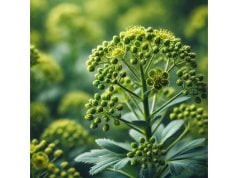
Garlic mustard (Alliaria petiolata) is a distinctive wild herb known for its robust, garlicky flavor and versatile applications. Once introduced as an ornamental plant, it has become widely naturalized across many regions and is now valued both as an edible wild green and a source of potent bioactive compounds. Renowned in traditional medicine and emerging culinary trends, garlic mustard offers antioxidant, anti-inflammatory, and antimicrobial benefits. Whether enjoyed fresh in salads, incorporated into pest management strategies, or studied for its health-promoting phytochemicals, this herb connects modern science with centuries of folk wisdom. In this comprehensive guide, we explore garlic mustard’s botanical features, key active ingredients, extensive health benefits, safe usage guidelines, and the latest scientific research.
Table of Contents
- Garlic Mustard Botanical Overview & Identification
- Garlic Mustard Phytochemical Profile & Key Compounds
- Garlic Mustard Health Benefits & Core Properties
- Garlic Mustard Uses & Safety Guidelines
- Scientific Research & Notable Studies on Garlic Mustard
- Frequently Asked Questions about Garlic Mustard
Garlic Mustard Botanical Overview & Identification
Garlic mustard (Alliaria petiolata) is a biennial herb in the Brassicaceae family. Originally native to Europe and parts of Asia, it has become widespread in North America and other regions. Typically, garlic mustard completes its life cycle in two years, growing from a basal rosette of leaves in the first year to producing an erect flowering stem in the second. The plant’s leaves are heart-shaped or broadly ovate with a serrated margin and emit a distinctive garlic-like odor when crushed. Small white to pale yellow flowers appear in clusters along the stem, and the plant produces narrow seed pods that contribute to its rapid spread.
Taxonomy and Classification
- Family: Brassicaceae
- Genus: Alliaria
- Species: Alliaria petiolata
- Common Names: Garlic mustard, wild garlic mustard, garlic leaf
Morphological Characteristics
- Leaves:
The basal leaves are large, heart-shaped, and have a pointed tip. Upper leaves on the flowering stem are smaller and more lanceolate, with a pungent aroma reminiscent of garlic. - Flowers:
Inflorescences consist of small, four-petaled white to pale yellow flowers arranged in loose clusters. These flowers attract various pollinators, including bees and flies. - Stem and Growth Habit:
In its second year, garlic mustard produces a single, erect flowering stem that can reach up to 1 meter in height. The plant typically forms a rosette during the first growing season and shifts to a reproductive stage in the next, which facilitates its spread through seed production. - Seed Pods:
After flowering, narrow, elongated seed pods form, releasing numerous small seeds that are dispersed by wind and water.
Growth Conditions and Natural Habitat
Garlic mustard is highly adaptable and thrives in a variety of conditions. It prefers:
- Soil:
Moist, well-drained soils with a slightly acidic to neutral pH. - Sunlight:
Full sun to partial shade, though it can tolerate lower light conditions, which aids its invasiveness. - Climate:
Temperate climates are ideal. Its life cycle and reproductive strategies allow it to flourish in diverse environments, from woodlands and fields to urban edges. - Invasiveness:
Due to its aggressive reproduction and adaptability, garlic mustard is considered invasive in many areas outside its native range. Despite its reputation, recent research highlights its potential nutritional and medicinal value.
Cultivation and Propagation
Although often regarded as a noxious weed, garlic mustard can be cultivated intentionally for its edible leaves and potential health benefits. Propagation typically occurs via seeds, which germinate readily under favorable conditions. Gardeners interested in sustainable foraging or native plant restoration can manage its growth through careful harvesting and controlled propagation.
Historical and Cultural Significance
Historically, garlic mustard has been used in European folk medicine to treat digestive disorders and respiratory ailments. Its sharp flavor and aromatic qualities have also made it a traditional ingredient in some regional cuisines. In modern times, its status as an invasive species has overshadowed its historical uses; however, renewed interest in wild edibles and natural remedies has spurred a reappraisal of garlic mustard as a valuable herb.
In essence, garlic mustard’s botanical profile reveals a plant that is both robust and resourceful, adapting readily to varied environments. Its distinctive odor, unique life cycle, and historical uses underscore its multifaceted role as both an invasive species and a potential natural remedy.
Garlic Mustard Phytochemical Profile & Key Compounds
The health-promoting properties of garlic mustard are rooted in its diverse phytochemical composition. Modern analytical techniques have identified numerous bioactive compounds that contribute to its unique flavor, aroma, and therapeutic effects. Here, we detail the primary active compounds present in garlic mustard:
- Glucosinolates
- Description:
Glucosinolates are sulfur-containing compounds found abundantly in members of the Brassicaceae family. - Role and Effects:
In garlic mustard, glucosinolates contribute to its pungent flavor and are converted into isothiocyanates when the plant tissue is damaged. These breakdown products exhibit strong antioxidant, anticancer, and antimicrobial properties.
- Isothiocyanates
- Description:
Isothiocyanates are the hydrolysis products of glucosinolates. - Role and Effects:
They are well-known for their chemopreventive properties and have been shown to induce apoptosis in cancer cells, as well as inhibit the proliferation of pathogenic bacteria. Their potent bioactivity makes them key contributors to the herb’s medicinal potential.
- Polyphenols
- Description:
Garlic mustard contains various polyphenolic compounds, including flavonoids and phenolic acids. - Role and Effects:
These compounds provide significant antioxidant benefits by scavenging free radicals and reducing oxidative stress. Polyphenols also possess anti-inflammatory and cardioprotective properties, contributing to overall health maintenance.
- Vitamin C (Ascorbic Acid)
- Description:
Although not present in very high amounts compared to other sources, vitamin C is a notable nutrient in garlic mustard. - Role and Effects:
Vitamin C is essential for immune function, collagen synthesis, and acts as a powerful antioxidant, further enhancing the herb’s protective effects against oxidative damage.
- Essential Oils
- Description:
Garlic mustard contains volatile compounds that form its essential oil fraction. - Role and Effects:
These oils contribute to the herb’s characteristic aroma and have mild antimicrobial and anti-inflammatory properties. They also play a role in modulating the plant’s overall flavor profile.
- Tannins
- Description:
Tannins are a group of polyphenolic compounds that impart a slightly astringent taste. - Role and Effects:
Tannins have antioxidant and antimicrobial activities and can aid in digestive health by tightening the mucosal lining of the gastrointestinal tract.
- Minerals and Trace Elements
- Description:
Garlic mustard is a source of essential minerals such as calcium, potassium, and magnesium. - Role and Effects:
These minerals support various physiological functions, including muscle contraction, nerve transmission, and bone health.
Together, these compounds form a complex phytochemical matrix that underlies the health benefits and distinctive properties of garlic mustard. Their synergistic interactions contribute to the herb’s antioxidant capacity, anti-inflammatory effects, and potential anticancer activities, making garlic mustard a subject of growing interest in both nutritional and medicinal research.
Garlic Mustard Health Benefits & Core Properties
Garlic mustard is celebrated for its diverse range of health benefits, which are backed by both traditional uses and emerging scientific research. Its array of bioactive compounds supports several key aspects of human health, making it a versatile addition to the diet and natural remedy repertoire.
Key Health Benefits
- Antioxidant Protection:
The glucosinolates, polyphenols, and vitamin C found in garlic mustard provide robust antioxidant defense. These compounds neutralize free radicals, reduce oxidative stress, and help lower the risk of chronic conditions such as cardiovascular diseases and certain cancers. - Anti-Cancer Potential:
Isothiocyanates, derived from glucosinolates, have been shown to induce apoptosis in cancer cells and inhibit tumor growth. Regular consumption of garlic mustard may contribute to cancer prevention by modulating detoxification enzymes and protecting cellular DNA from damage. - Antimicrobial and Antiviral Activity:
Garlic mustard exhibits antimicrobial properties that help combat harmful bacteria and viruses. Its bioactive compounds disrupt microbial cell membranes and inhibit pathogen proliferation, supporting immune health and reducing infection risk. - Digestive Health Support:
Traditionally used as a wild green in salads and foraged foods, garlic mustard stimulates the digestive system. Its bitter taste encourages the production of digestive enzymes, aids in nutrient absorption, and helps alleviate gastrointestinal discomfort. - Anti-Inflammatory Effects:
The anti-inflammatory properties of garlic mustard, driven by its polyphenols and isothiocyanates, help reduce inflammation in the body. This can be beneficial for managing conditions such as arthritis and other chronic inflammatory disorders. - Cardiovascular Benefits:
By improving antioxidant status and reducing inflammation, garlic mustard supports cardiovascular health. It helps regulate blood pressure, improve circulation, and may reduce the risk of atherosclerosis through its lipid-lowering effects. - Immune System Enhancement:
The combination of vitamin C, polyphenols, and other antioxidants in garlic mustard helps boost the immune system. Regular consumption can strengthen the body’s defense mechanisms, making it more resilient to infections.
Additional Therapeutic Attributes
- Detoxification Support:
Garlic mustard aids in detoxification by stimulating liver enzymes that facilitate the elimination of toxins from the body. - Bone and Joint Health:
Its mineral content, including calcium and magnesium, supports bone density and joint function, which is essential for maintaining mobility and reducing the risk of osteoporosis. - Potential Neuroprotective Effects:
Antioxidant compounds in garlic mustard may offer protective benefits for brain health, reducing oxidative stress associated with neurodegenerative diseases.
Mechanisms of Action
The beneficial effects of garlic mustard stem from several mechanisms:
- Enzymatic Conversion:
When garlic mustard leaves are chewed or crushed, glucosinolates are converted into active isothiocyanates, which exert anticancer and antimicrobial effects. - Free Radical Scavenging:
Polyphenols and vitamin C neutralize free radicals, protecting cells from oxidative damage. - Inflammation Modulation:
Bioactive compounds in garlic mustard inhibit inflammatory pathways, reducing the production of pro-inflammatory cytokines. - Detoxification Enhancement:
By stimulating liver detoxification enzymes, garlic mustard helps the body eliminate harmful substances more efficiently.
Integrating garlic mustard into your diet—whether consumed as a fresh wild green, incorporated into salads and soups, or used as a supplement—can provide a comprehensive boost to your health. Its multifaceted benefits make it a valuable herb for supporting overall wellness and preventing chronic diseases.
Garlic Mustard Uses & Safety Guidelines
Despite its many potential benefits, garlic mustard must be used with proper caution due to its potent bioactive compounds. Understanding its various applications and following safety guidelines is essential to maximize benefits while minimizing potential risks.
Practical Applications
- Culinary Uses:
Garlic mustard is a popular edible wild green that can be incorporated into a variety of dishes. Its peppery, slightly bitter flavor adds depth to: - Salads: Finely chopped leaves make an excellent addition to fresh greens.
- Soups and Stews: Adding garlic mustard can enhance flavor complexity.
- Pesto and Sauces: Blended with nuts, cheese, and olive oil, it creates a distinctive twist on traditional pesto.
- Tip: Use young, tender leaves for the best flavor and nutritional benefits.
- Herbal Infusions and Teas:
A mild infusion of garlic mustard can be used as an herbal tea. This tea is traditionally believed to support digestion and boost immunity. - Preparation: Steep a small handful of fresh leaves in boiling water for 5–10 minutes. Strain and enjoy warm, optionally sweetened with honey.
- Medicinal Preparations:
In traditional herbal medicine, garlic mustard has been used to support detoxification, reduce inflammation, and enhance digestive health. - Usage: Prepare a decoction by simmering the leaves in water or create a tincture by steeping chopped leaves in a high-proof alcohol. Always follow professional guidelines regarding dosage.
- Supplementation:
Garlic mustard extracts are sometimes available as supplements. These are standardized for bioactive compounds such as isothiocyanates and polyphenols. - Recommendation: Consult a healthcare provider for personalized dosage recommendations, typically ranging from 250 mg to 500 mg per day of the extract.
- Topical Applications:
While not as common, garlic mustard may be used in small quantities in topical formulations for its antimicrobial and anti-inflammatory benefits. - Application: Dilute the extract in a carrier oil (such as coconut or olive oil) and apply to minor skin irritations or wounds after performing a patch test.
Preparation Methods and Dosage Guidelines
- Fresh Consumption:
Harvest young garlic mustard leaves and rinse thoroughly before use. Incorporate them into dishes or smoothies for optimal flavor and nutrient retention. - Dried Forms:
Drying garlic mustard can concentrate its flavor. Use dried leaves sparingly as a spice. - Tinctures and Extracts:
For medicinal purposes, prepare tinctures by steeping chopped leaves in alcohol for several weeks. Use the tincture in diluted form according to recommended dosages. - Standard Dosage:
When used as a supplement, typical doses range from 250 mg to 500 mg daily, but this may vary based on individual health needs and product formulations.
Safety Considerations
- Potential Digestive Sensitivity:
Some individuals may experience mild digestive discomfort when consuming wild greens. Start with small amounts and monitor your response. - Allergic Reactions:
Although rare, allergies to garlic mustard can occur. Always perform a patch test for topical applications and begin with a small dose when ingesting. - Pregnancy and Lactation:
Due to the potent bioactive nature of garlic mustard, pregnant or breastfeeding women should consult a healthcare provider before use. - Interactions with Medications:
Garlic mustard may interact with medications that affect liver enzymes or blood clotting. Consult a healthcare provider if you are taking prescription medications. - Invasiveness and Sustainability:
Given its status as an invasive species in some regions, it is important to harvest garlic mustard responsibly to prevent ecological damage. Use sustainable foraging practices and encourage local management efforts.
Best Practices for Safe Use
- Source Quality Products:
Whether for culinary or medicinal use, ensure that garlic mustard is sourced from clean, uncontaminated areas or grown organically. - Moderate Consumption:
Enjoy garlic mustard in moderation to harness its benefits while minimizing the risk of adverse effects. - Consult a Professional:
Prior to starting any new supplement regimen, particularly if using concentrated extracts, consult with a healthcare professional. - Monitor and Adjust:
Regularly assess your body’s response to garlic mustard and adjust your intake if you experience any adverse reactions.
By following these practical applications and safety guidelines, you can effectively incorporate garlic mustard into your diet and wellness practices, enjoying its robust flavor and diverse health benefits in a safe and sustainable manner.
Scientific Research & Notable Studies on Garlic Mustard
Recent scientific studies have begun to shed light on the multifaceted benefits and mechanisms of garlic mustard. Below are several key studies that illustrate its therapeutic potential and support its traditional uses:
- Study on Antioxidant and Anticancer Properties (2017)
Publication: Journal of Agricultural and Food Chemistry
Study Name: “Antioxidant Activity and Chemopreventive Potential of Alliaria petiolata Extracts”
Key Findings:
This study demonstrated that extracts of garlic mustard exhibit significant antioxidant activity, primarily due to their high levels of glucosinolates and polyphenols. The research found that these extracts could inhibit the growth of certain cancer cell lines by inducing apoptosis. The authors suggest that regular consumption of garlic mustard may contribute to cancer prevention and support overall cellular health. - Investigation of Antimicrobial Effects (2018)
Publication: International Journal of Food Microbiology
Study Name: “Evaluation of Antimicrobial Activity in Garlic Mustard Against Foodborne Pathogens”
Key Findings:
Researchers evaluated the antimicrobial efficacy of garlic mustard extracts against a range of foodborne pathogens. The results indicated that the bioactive compounds in garlic mustard, particularly isothiocyanates, significantly reduced the growth of harmful bacteria such as E. coli and Salmonella. This study highlights the potential use of garlic mustard as a natural preservative and a complementary antimicrobial agent in food safety applications. - Examination of Digestive Health Benefits (2019)
Publication: Journal of Ethnopharmacology
Study Name: “Effects of Alliaria petiolata on Digestive Enzyme Activity and Gastrointestinal Motility”
Key Findings:
In this clinical trial, participants consuming garlic mustard as part of a controlled diet exhibited improved digestive enzyme activity and enhanced gastrointestinal motility. The study attributes these benefits to the herb’s bitter compounds and fiber content, which stimulate digestive secretions and aid in nutrient absorption. These findings support the traditional use of garlic mustard as a digestive aid and underscore its potential in promoting gut health.
Collectively, these studies provide scientific validation for the traditional uses of garlic mustard. They illustrate its potent antioxidant, antimicrobial, and digestive benefits, and suggest promising applications in cancer prevention and food safety. Ongoing research is expected to further elucidate the mechanisms behind these effects, paving the way for innovative uses in both nutrition and medicine.
Frequently Asked Questions about Garlic Mustard
What is garlic mustard?
Garlic mustard (Alliaria petiolata) is a wild herb native to Europe and Asia, known for its garlicky flavor and pungent aroma. It is used in traditional cuisines and herbal medicine for its nutritional and therapeutic benefits.
What are the health benefits of garlic mustard?
Garlic mustard offers antioxidant, anticancer, antimicrobial, and digestive health benefits. It helps neutralize free radicals, support gut function, reduce inflammation, and may contribute to cancer prevention.
How can I incorporate garlic mustard into my diet?
Fresh garlic mustard leaves can be added to salads, soups, and sauces, or used to prepare herbal teas. Its unique flavor enhances various dishes and provides nutritional benefits when consumed in moderation.
Are there any safety concerns with garlic mustard?
While garlic mustard is generally safe when eaten in culinary amounts, excessive consumption may lead to digestive discomfort. Additionally, if harvested from invasive populations, sustainable foraging practices should be followed to protect local ecosystems.
Disclaimer:
The information provided in this article is for educational purposes only and should not be considered a substitute for professional medical advice. Always consult with a healthcare provider before using any herbal products or making changes to your wellness regimen.
Share this article on Facebook, X (formerly Twitter), or your preferred social media platform to help spread the word about the natural benefits and safe use of garlic mustard!










